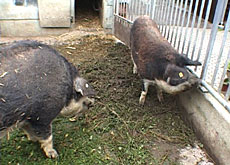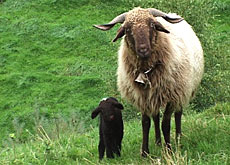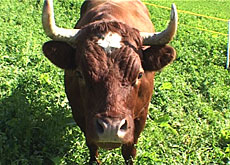Saving the woolly pig

Once upon a time, woolly pigs were valued members of most Swiss households, but their place was usurped by faster-growing breeds with higher meat yields.
But the woolly pig may yet live to grunt another day, thanks to the work of the Swiss environmental protection foundation, Pro Specie Rara.
The common type was the Swallow Bellied Mangalitza, a black-bristled robust animal well adapted to cold climates. It rarely became sick, and produced high quality meat. Yet despite these useful qualities, by the 1980s there were hardly any left in Europe.
The breed was originally farmed in the Austro-Hungarian Empire, and was a favourite among pig breeders, yielding fine meat and lard, and bristles that could be used as stuffing material.
Until the Second World War, the pigs were so valuable that they were traded as a commodity on the Vienna stock exchange. Many were imported into Switzerland.
But with the onset of industrialisation, farming communities dwindled as poor mountain dwellers sought work in the cities. A new breed of fast-growing Noble pigs was imported from England, which won popularity among Swiss farmers because of its high meat yield.
Ham and cutlets from the pink pigs were suddenly more in demand than bacon and lard from the Mangalitza. The woolly pig’s days seemed to be numbered.
In 1986, Pro Specie Rara stepped in to stop the race dying out altogether, encouraging farmers to breed the species. Eight years later, a dedicated breeders association was established. It now has 70 members, including Paul Stutz from Bern.
Pig breeder
Paul’s main income is from his job as a caretaker at a home for dysfunctional children in Bern. But his passion is his three pigs.
“I am keeping these animals for the next generation. It is their inheritance”, he says proudly.
Paul’s smallholding is right next to the children’s home, and is a popular visiting place for the infants. “Many ten year olds who come here for the first time have never even seen a pig,” he says.
Paul started breeding woolly pigs five years ago, and has raised 150 so far. They like to roam in the muddy field behind his house, where they can wallow and cool themselves in the summer. There are also a number of stalls, where the animals take shelter when it’s cold or raining.
Genetic superiority
Paul is full of praise for his porcine charges. “They have many genetic factors which have gone missing in modern pigs due to intensive farming. These ones are selectively bred, not crossbred, as is the common practice. When people used to keep these animals, there were no vets, no animal hospitals.”
The part-time farmer fetches a wheelbarrow and delivers a fresh load of vegetable peelings to the three hungry animals in the stalls, which grunt with delight.
“I can give them various types of food without them getting sick. You have to be careful with Noble pigs. They suffer from indigestion and diarrhoea if you change their diet. And when it comes to childbirth, these woolly pigs build nests. I don’t even have to attend the birth, unlike with Noble pigs.”
A perfect coupling
There are only 200 animals in the Swiss herd at the moment, which is considered to be too few to ensure their long-term survival.
If Paul needs a new sow, because one of his are too old or is not sufficiently maternal, he contacts the Woolly Pig Association’s Director of breeding, who consults the herd book to find a match in Switzerland that is not too closely related to Paul’s boar. Proper paring reduces the risk of genetic deformities in the litter.
Paul has a very clear idea of what he is looking for: “They must belong to the traditional species. They have to be healthy and capable of living happily in family groups, of being good mothers and fathers.
“The individuals in the family all have to get along. We need to be able to leave them outside on the fields, even in winter, without them getting sick”.
His passion for rare and endangered species is not confined to the hog. Paul also keeps Engadine and Roux du Valais sheep, in a separate field.
And then there are the rare vegetables, and fruit. His sturdy farmhouse, set back off the road, is surrounded by a sea of late blooming flowers, and orchards in which rare apples grow. He plucks the fruit from one of the trees.
“Nobody wants these any more”, he tells me. “They are just too big. The ones you find in the Migros supermarket are much smaller. It’s a shame”.
In the cellar are so-called blue potatoes, which are actually purple in colour. Paul washes one of them in the ancient water trough in the yard, and cracks it open like a nut. Paul is less enthusiastic about this particular variety.
“These taste just like normal potatoes, but they split and become diseased very easily. I can see why people don’t grow them any more.” He throws the two halves of potato into the pigpen. They disappear within seconds. One customer, at least, is very satisfied.
swissinfo, Julie Hunt
Paul Stutz’s smallholding next to the school where he is caretaker continues to fascinate his mostly young visitors. In stalls and on paddocks around his house are endangered species of pigs and sheep, as well as a vociferous donkey and a number of goats. Paul loves to explain to the children that this is their inheritance.
The woolly pig is highly endangered, with only 200 in the herd.
Paul Stutz from Bern has bred 150 of them in 5 years.
They are robust and rarely become sick, unlike intensively farmed, fast-growing pigs.
They were once considered so valuable, that they were traded on the Vienna stock exchange.
Their meat is now sold to specialist butchers.
I am keeping these animals for the next generation

In compliance with the JTI standards
More: SWI swissinfo.ch certified by the Journalism Trust Initiative



You can find an overview of ongoing debates with our journalists here. Please join us!
If you want to start a conversation about a topic raised in this article or want to report factual errors, email us at english@swissinfo.ch.